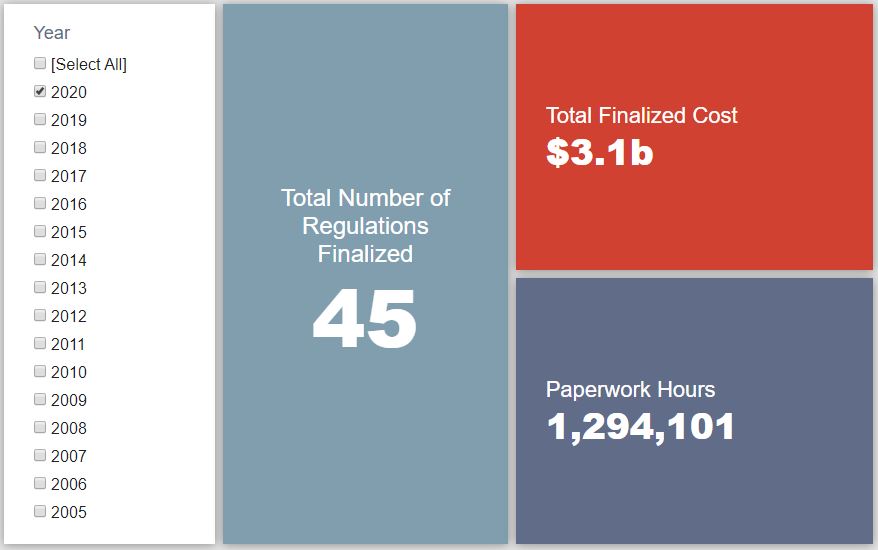Week in Regulation
February 24, 2020
Railroad and Health Care Rules Mark Short Week
With only four work days due to Presidents’ Day, it is hardly shocking that there was only limited action in the Federal Register last week. Most of the rulemakings with some economic estimate attached did not exceed more than a few million dollars in total impact (either via savings or costs). A pair of deregulatory proposals from the Department of Health and Human Services (HHS) and a regulatory action from the Department of Transportation (DOT) proved to be the exceptions. Across all rulemakings, agencies published $47.1 million in total net cost savings but added 1.3 million hours of annual paperwork.
REGULATORY TOPLINES
- 2020 Proposed Rules: 41
- 2020 Final Rules: 53
- 2020 Total Pages: 10,246
- 2020 Final Rule Costs: $3.1 billion
- 2020 Proposed Rule Costs: $3.5 billion
TRACKING THE REGULATORY BUDGET
The most notable deregulatory actions of the week both came from HHS. The pair of proposed rules both adjust certain aspects of the Medicare and Medicaid programs. HHS estimates that the rulemakings would yield annualized savings of $4.4 million and $3.4 million, respectively. In terms of present value, their combined total is roughly $111 million in savings. Since they are both proposed rules, however, these savings do not yet apply to the fiscal year (FY) 2020 regulatory budget.
The most significant regulatory action – and the one that actually applies to the FY 2020 budget – is a rule from DOT regarding the “Risk Reduction Program” for freight rail. The rule sets new requirements for how Class 1 and “inadequate safety performance” (ISP) railways establish their safety plans. DOT estimates that these new requirements will impose costs of roughly $40 million on affected entities.
The Trump Administration expects to reach $51.6 billion in cumulative net savings in FY 2020. To date in the fiscal year, agencies have finalized 55 deregulatory actions and 16 regulatory actions, totaling $2.1 billion in quantified total net costs.
THIS WEEK’S REGULATORY PICTURE
This week, the White House Council of Economic Advisers (CEA) offers its assessment of the Trump Administration’s regulatory reforms.

On February 20 the CEA released its annual Economic Report of the President, which included a chapter dedicated to showing that the administration’s deregulatory efforts benefit the real incomes of households. CEA estimates that regulatory reform will “have raised real incomes” by $3,100 per year after 5 to 10 years, once the effects of the reforms are more fully realized. These benefits come in the form of increased choice, productivity, and competition.
Though the report comes from the White House and accordingly paints a rosy portrait of deregulation’s effects, and it is limited to primarily looking at the impact of 20 notable deregulatory actions, it does help to offer insight into how the regulatory savings of the administration can benefit the economy.
For example, CEA estimates that even if the Trump Administration’s deregulatory actions are removed, the slowed rate of new regulation has had an impact. It calculates the amount added to real incomes in the fifth year of such a regulatory slow down to be .8 percent, or about $1,200 per household. Adding deregulatory actions back in adds a further $1,900 to real incomes. The report also notes the opportunity for additional economic benefit to come from projected savings from its FY 2020 regulatory budget ($51.6 billion) and recently signed executive orders on guidance documents.
Estimating the economic effect of regulations (or deregulations) is extremely difficult, since they are typically not measurable until years after the fact and often intertwined with other economic factors. But the CEA report does help gauge the impact of one of the administration’s more successful economic policies.
TOTAL BURDENS
Since January 1, the federal government has published $6.6 billion in total net costs (with $3.1 billion in finalized costs) and 14.2 million hours of net annual paperwork burden increases (with 1.3 million hours due to final rules). Click here for the latest Reg Rodeo findings.












